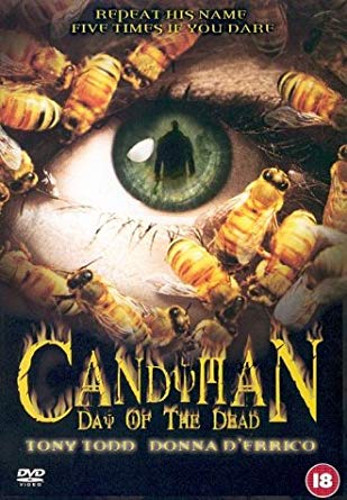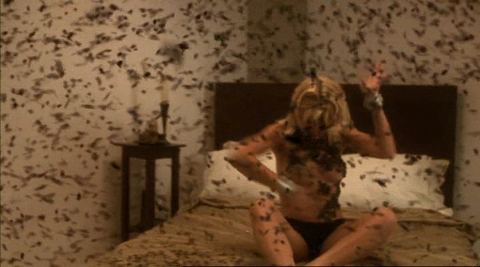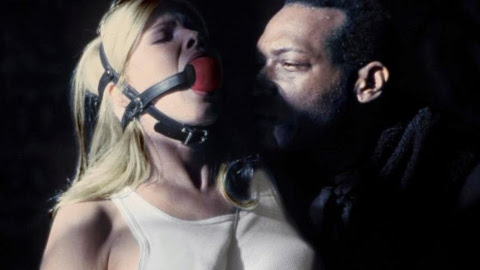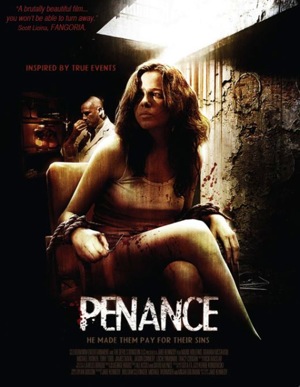Candyman: Day of the Dead (1999)
Directed by: Turi Meyer
Written by: Al Septien, Turi Meyer
Starring: Donna D'Errico, Jsu Garcia, Tony Todd, Wade Williams
USA
AVAILABLE ON BLU-RAY [REGION ‘A’ ONLY] AND DVD
RUNNING TIME: 95 mins
REVIEWED BY: Dr Lenera, Official HCF Critic
It’s quite a few years after the Candyman killings in New Orleans and Annie Tarrant’s daughter Caroline McKeever is now grown up and living in Los Angeles. She owns Daniel Robetaille’s paintings which she has chosen to show at the gallery of an aspiring artist named Miguel Valasco. During the evening before the Day of the Dead festival, she’s tempted by Miguel into saying Candyman’s name five times to prove his supposed non-existence. Although nothing happens while she is at the gallery opening, murders then begin to occur which are initially blamed on David de la Plaz, who Miguel hired to pretend to be Candyman at the exhibition opening….
It seems that this is generally regarded as the worst of the three Candyman films, and I recalled it being so, but this time around I found it to be just a little bit better than Candyman: Farewell To The Flesh. It’s not much of an improvement, still almost entirely lacking the classiness, intelligence and depth of the first movie, though considering the second one having those features absent but not replacing them with much else, I didn’t mind that this episode had a more exploitative vibe about it, with more bloody killings and quite a bit of topless nudity [okay ,the first film had Virginia Madsen naked in one scene but if you were remember it was anything but sexual]. Director Turi Mayer, whose only other non-TV credit is the stupid supernatural serial killer flick Sleepstalker, doesn’t possess the know-how to stop the DTV movie from looking cheap, and rarely tries to create much in the way of atmosphere. However, while it basically rehashes episode one yet again – far more in fact than episode two – there are a few good ideas contained within Mayer and Al Septain’s screenplay, even if they’re not utilised to their potential. The notion of the only way to kill Candyman being to destroy the myth of Candyman is a great concept, but it’s handled in the simplest possible fashion. Likewise, the idea of a Candyman cult, even if possibly inspired by developments in the Halloween series, had potential, but it’s introduced and then almost immediately got rid off and is just an excuse for Candyman to have some more victims – whom he mostly kills offscreen.
A rather well handled dream sequence opens the film, though our heroine has so many dreams throughout that it’s almost like watching an installment from a certain other horror franchise – though thankfully Candman is still taken seriously, which is just as well since there are a few other things to laugh at in this film. That first dream of Caroline in bed, the bathroom door creaking open, her going into the totally white bathroom and seeing “sweets to the sweet” [no, me neither] written in blood on the wall, does have something of a nightmare feel, but then two things become apparent. The first is how important Philip Glass’s music was to the first two films, ensuring that this was a franchise with a strong musical identity much like Halloween and Friday The 13th. It was some time before Michael Myers and Jason Voorhees did their slaying to a different tune and at least in the case of Myers the original theme still popped up here and there. But here Glass’s work is totally dispensed with, to be replaced by Adam Gorgoni’s mediocre synth efforts and a very misjudged main title piece consisting of a hip-hop beat and a bit of chanting set awkwardly to admiring images of Candyman’s hook [which in this one is more phallic than ever]. The second noticeable feature is that instead of getting somebody who could act like before, the producers decided to cast a Baywatch babe as the heroine. Donna D’Errico is downright awful in the part, either totally wooden or totally over-the-top, the only scene in which she seems natural being when she’s having sex.
She narrates the familiar tale of Daniel Robetaille to the viewer, who soon after hears it again from painter Miguel. Some flashback shots at last let us see Robetaille and his love together in a carnal way, but why on earth does his execution now appear to occur at night time? It’s the kind of shoddy continuity that you get in the Universal black and white horrors, but I’m a bit more forgiving of them because they were only originally intended to be seen in cinemas when they first came out and viewers of the next installment may have forgotten details. Anyway, Caroline doesn’t like the way Miguel is emphasising the Candyman stuff over Robetaille’s humanity and art for the sake of commerce, and is then scared shitless when Miguel gets actor David to pose as the hook-handed demon and then cry “he will come for us”. Of course he soon does, and first to go are Miguel and his pick-up, the latter succumbing to bees who go all over her naked body after she’s smeared honey over it. The bees appear a bit more in this one, though of course they don’t always convince even though they’re sometimes CGI this time. David is blamed for the murders, but Caroline thinks that a local gang did it so her and David decide to track them down. There’s an especially badly acted scene where the two get drunk and don’t act any differently to normal, D’Errico and Jsu Garcia, who often acts like he’s in a bad sitcom, not even seeming to try – or maybe Mayer, who clearly can’t handle actors very well, just told them to be this way.
After a while Caroline becomes the one blamed, and we also learn what happened to her mother who was of course the heroine of the previous film. She makes an effective if unoriginal appearance in one of the dream sequences, appearing out of a bath covered in blood, and is often used in quick flashback shots which are perhaps a little annoying but clearly Mayer’s way of reminding us of the family element of the story which is certainly strongest in this one. I do like the way both of these sequels link to their predecessor. Candyman does his usual stuff, and his first appearance in a graffiti-filled underground railway station [though why would any woman – indeed anybody – sit in such a creepy place and wait for a train on her own?] is the film’s sole really atmospheric scene, and it’s in fact one of the most atmospheric in all the three movies. Maybe it was directed by someone else? Candyman also gets to commit some memorable kills, notably one in a car that’s actually a bit of a shocker – and it’s followed by another shock when the person isn’t quite dead and tries to strangle Caroline, though like film number two there are rather too many false scares – a few add to the fun of a horror film, but too many and it just seems like the director is trying to compensate for the lack of actual scares. Candyman mostly does stuff he’s done before, like revealing his insides to the heroine when he opens his coat in a bit which was probably copied from Black Sunday, and the way to defeat him appears to be just suddenly thought up by Caroline on the spot as well as probably being inspired by another semi-horror classic from 1946, though it’s kind of logical really. The lack of budget – or is that Mayer’s and cinematographer Michael J. Wojciechowski’s lack of skill in making stuff look good? – really shows in the sets towards the end, and what’s with that shoddy shot of a building [used twice] where they’ve obviously put an orange filter over the sky in color correction, but covered up the top of the building as well!
Later dreams present the odd unusual image like blood coming out of an egg, while Tony Todd retains his dignity. In fact he seems especially motivated here, and more sexual too, while the film doesn’t fall into the trap of pitying him too much as well as resisting the temptation to give him loads of screen time – though you’ll probably easily get tired of him saying: “be my victim” all the time. I’m not entirely sure what he’s trying to do in this film either, as he seems to be acting in the exact opposite way that he does in the previous episode by specifically trying to kill his remaining relatives, wanting to bring them over to the dead side with him. In a way the role of major villain is filled by Lt. Det. Samuel Deacon Kraft, a racist cop who’s truly loathsome and even rather scary due to William Wade’s fine acting in the part, the actor refusing to turn the character into a cartoon even though the role is only fairly thinly sketched by the screenplay. Unfortunately, despite the title the Day of the Dead festival barely plays a part in the proceedings which is something of a waste.
In the end Candyman: Day Of The Dead has a few bad aspects to it that can’t be ignored, but for a cheapie DTV sequel it really isn’t bad overall and they did try to do the best with what they had. I guess they had a hunch that there wouldn’t be a fourth one, as Candyman really does seem to be gone for good at the end which is rather satisfying being that this was the end of this series, and, while the way in which his myth is destroyed is extremely hastily done, I guess it kind of make sense considering that Helen is probably still being blamed for the killings in 1992 and no doubt Annie is being considered the killer in New Orleans. Though I slightly [only slightly] preferred Day Of The Dead to Farewell To The Flesh, neither sequel of course comes anywhere near the original Candyman, and, while the idea of Jordan Peele producing a remake has been welcomed by some because of Peele’s fine handling of horror with racial dynamics in Get Out, I just can’t see him matching Bernard Rose’s efforts at all.











Be the first to comment